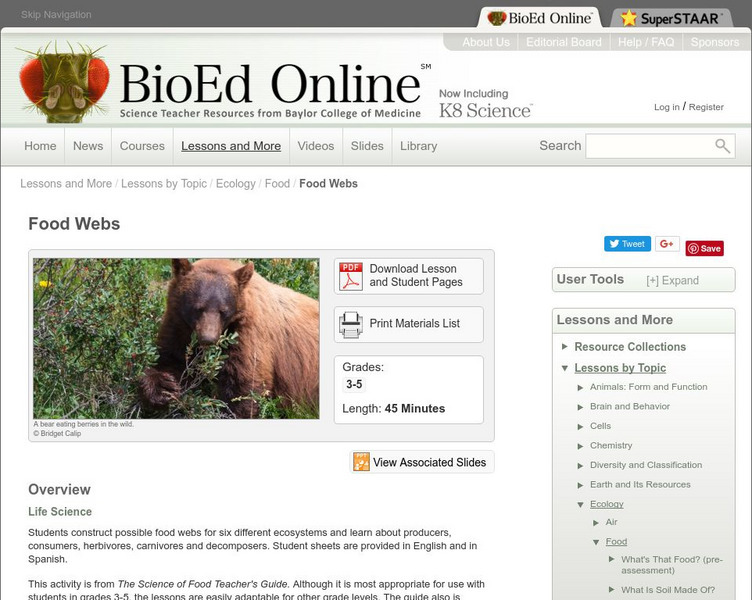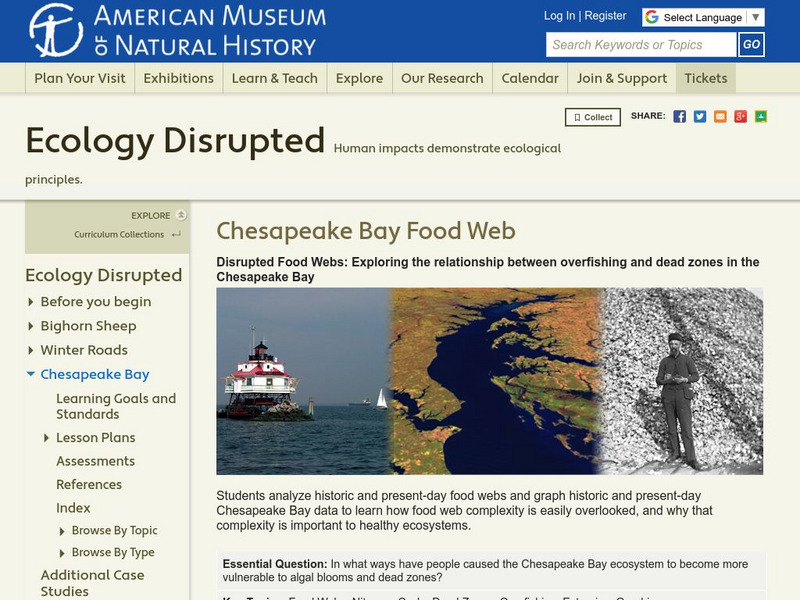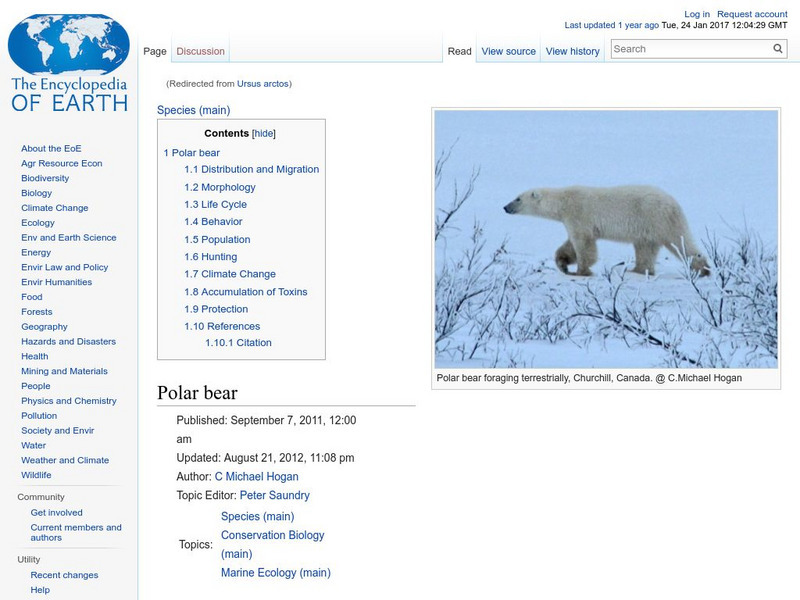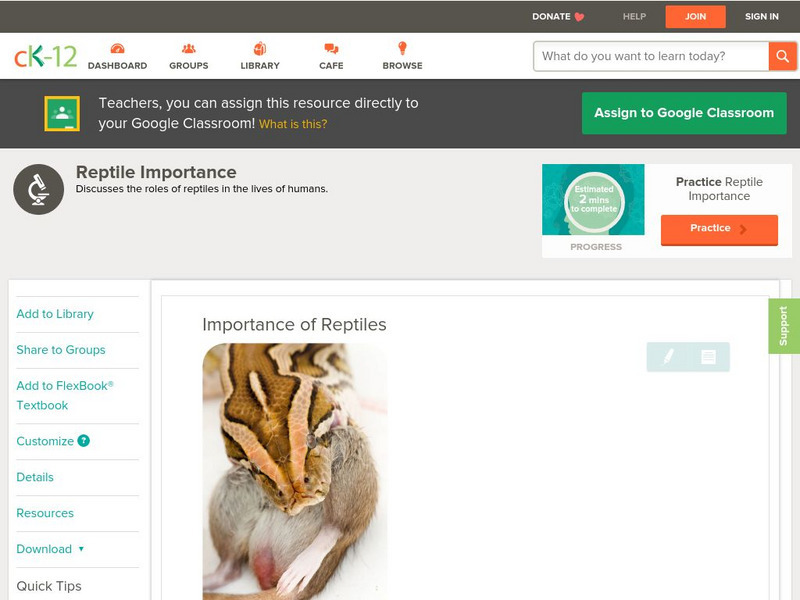Hi, what do you want to do?
National Geographic
National Geographic: Marine Food Webs
For this lesson, students learn about marine food webs and pyramids, and how energy flows through a marine ecosystem. They then research a marine organism and its role in a marine food web. The class pools their information to create a...
Smithsonian Institution
National Museum of Natural History: Ocean Planet
Detailed website that was a companion to a 1995 traveling exhibit of the Smithsonian. Links to lesson plans and other educational materials are at the bottom of the page. Enter the exhibition to explore the world of the ocean.
BioEd Online
Bio Ed Online: Food Webs
Students construct possible food webs for six different ecosystems as they learn about the roles of producers, consumers, herbivores, carnivores and decomposers.
Annenberg Foundation
Annenberg Learner: The Habitable Planet: Ecology Lab
Create the parameters of your own ecosystem by choosing which producers and consumers live there. Visualize how the food web operates and species populations change. This simulator mimics the food web within a typical ecosystem and gives...
American Museum of Natural History
American Museum of Natural History: Ecology Disrupted: Chesapeake Bay Food Web
In this comprehensive lesson plan unit, students examine how overfishing has affected Chesapeake Bay's ecosystem. They will study food webs from the past and present and graph related data.
Other
Digital Library for Earth System Education: Teaching Box: Seasonal Upwelling
A suite of lessons focusing on the process of upwelling. Inquiry-based exploration of seasonal upwelling includes marine food webs, food production in the ocean, wind-driven ocean currents, and seasonal changes in biotic and abiotic...
Utah Education Network
Uen: Nhmu: Living Food Web
Fourth graders will be able to name some plants and animals that live in Utah's desert, forest or wetland ecosystems.
Tramline
Virtual Field Trip: Temperate Forest Biome
Travel with your students on a Virtual Field Trip to learn about Temperate Forest Biomes. You will also discover many informative and interactive websites.
Museums Victoria
Museum Victoria: Bugs
Students learn what insects are, how they live, how they find food, how they defend themselves, and how they affect humans. Organized into several articles accompanied by high-quality photos and video, this online exhibit provides...
Annenberg Foundation
Annenberg Learner: The Habitable Planet: Ecosystems: Energy Flow Through
Detailed explanation of the processes by which energy flows through an ecosystem. Scroll down and open Section 3.
Utah Education Network
Uen: Trb 4:5 Investigation 3 Web of Life
Understand environments and how organisms adapt to their environment.
Georgia Department of Education
Ga Virtual Learning: Ecosystems
This module offers an in depth study of the fundamental components of ecosystems. Activities include mini-lessons with videos and student assignments.
Massachusetts Institute of Technology
Mit: Open Course Ware: Courses: Civil Environmental: Ecology I: The Earth System
College-level online course highlighting the fundamentals of ecology. Course topics include coevolution of the biosphere, geosphere, atmosphere, and hydrosphere; photosynthesis and respiration; and the carbon, nitrogen, and water cycles....
Georgia Department of Education
Ga Virtual Learning: Marine Invertebrates
Students learn about invertebrates found in the ocean, their individual methods of adaptations, identifying characteristics, and contributions to the marine ecosystem.
Encyclopedia of Earth
Encyclopedia of Earth: Conservation Biology: Polar Bear
Information about the polar bear: physical characteristics, behavior, life cycle, distribution, threats to their survival, conservation efforts, etc. (Published Sept. 7, 2011)
Georgia Department of Education
Ga Virtual Learning: Ap Environmental Science: Science, Matter, Energy, Systems
Through interactive activities, reading exercises, and lab activities, students study how science, matter, energy, and systems are interrelated.
Concord Consortium
Concord Consortium: Stem Resources: Predators and Prey
Did you ever want to be a hawk? In this virtual ecosystem, students will take on the role of a hawk and try to catch rabbits on a snowy field. Students will see which rabbits have adaptations that allow them to blend into the environment...
Globio
Glossopedia: Fishes
Learn about fish from around the world. Varying species, their biology, role in the environment, human cultural significance, as well conservation issues.
CK-12 Foundation
Ck 12: Life Science: Importance of Reptiles
[Free Registration/Login may be required to access all resource tools.] Reptiles play an important role in the life of humans. In addition to playing an important role in many food chains, which keep the populations of small animals...
Thinkport Education
Thinkport: Designing a Healthier, Happier Meal: Children's Meal Data
See a chart that contains a sampling of children's meals available in 2013 at 14 national fast food chains.
Encyclopedia of Earth
Encyclopedia of Earth: Ddt
Information about the insecticide DDT, a toxic chemical that was used widely in World War II and later, and is still used in some countries today. It has had far-reaching effects on the environment, as it is carried long distances by air...
National Pest Managment Association
Pest World for Kids: Termitology
An inquiry based lesson plan that delves into termite biology, distribution and habitat, life cycle, social structure, and the role of termites in nature and the food chain.
Wonderville Media
Wonderville: African Lions
The African lion is at the top of the food chain and is often called "the king of the jungle." It is the biggest carnivore in Africa and remains one of the most feared predators on the planet. Lions are well known for their courage and...
Enchanted Learning
Enchanted Learning: Plankton
Enchanted Learning takes a basic look at a basic organism: plankton. Learn the definition of plankton, zooplankton and phytoplankton; the first link in the marine food chain.
Other popular searches
- Desert Food Chain
- Animal Food Chain
- Deciduous Forest Food Chains
- Pond Food Chain
- Ocean Food Chain
- Frog Food Chain
- Food Chains in Biomes
- Arctic Food Chain
- Desert Animal Food Chain
- Ocean Animals Food Chain
- Coral Reef Food Chain
- Marine Science Food Chain




















